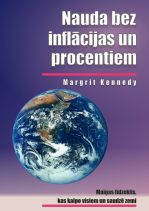Bernards Lietaers par Šveices WIR norēķinu sistēmu
Autors egleskoks @ 23. Jan 2009
Bernards Lietaers 2008. gada beigās ir uzrakstījis ļoti interesantu un sakarīgu rakstiņu par mūsdienu ekonomiskās sistēmas trausluma cēloņiem, un kā piemēru risinājumam piemin Šveicē darbojošos WIR norēķinu sistēmu. Vienā teikumā, ideja vienkārša: ja bankas nedod naudu, sametīsim paši, jo tas ir kopējās interesēs. Zemāk fragments no 23. lappuses angliski, kamēr neesmu pārtulkojis latviski:
Once upon a time, during a crisis similar to the one we are now mired, sixteen businessmen got
together to decide what they could do among themselves. They or their clients had each received
a notice from their respective banks that their credit line was going to be reduced or eliminated;
hence bankruptcy was only a question of time. They realized that business A had needed the bank
loan to buy goods from business B, which in turn needed money to buy stuff from its own
suppliers. So they decided to create a mutual credit system among themselves, inviting their
clients and suppliers to join. When business A buys something from B, A gets a debit and B the
corresponding credit. They created their own currency, whose value was identical to the national
money, but with the interesting feature that it didn’t bear interest.
The country’s banks mounted a massive press campaign to try to squelch this revolutionary idea.
Miraculously, that campaign failed, and this little system saved the businesses involved at the
time. A cooperative was set up among the users to keep the accounts dealing with that currency.
Soon participants could also borrow from that cooperative in that currency at the remarkably low
interest rate of 1% to 1.5%. All such loans need to backed by inventory or other assets. Over time,
the system grew to include up to one quarter of all the businesses of the entire country.
Sixty-five years later, an American professor performed an econometric study proving that the
secret for the country’s legendary economic stability was that strange little unofficial currency,
circulating among businesses in parallel with the national money. That well-known economic
resilience was usually credited to some mysterious and unknown national characteristic.
Whenever there was a recession, the volume of activity in this unofficial currency would expand
significantly, thereby reducing the recession’s impact on sales and unemployment. Whenever
there was a boom, business in national currency expanded, while activity in the unofficial
currency proportionally dropped back again. The surprising implication of this study is that the
spontaneous counter-cyclical behavior of this little “unorthodox” system actually helped the
central bank of the country in its efforts to stabilize the economy.
This is not a fairy tale, but the true story of the WIR system. The country is Switzerland and the
sixteen founders met in Zurich in the year 1934. And the system is still operating today. The
annual volume of business in the WIR currency is now about $2 billion per year. The American
professor is James Stodder from Rensselaer University. His remarkable quantitative study uses
more than 60 years of high quality data to prove the points made in this story. The WIR system is
also now accepting deposits and making loans in Swiss Francs as well as in WIR.
Domāju, ka arī Latvijā tas varētu strādāt.
Tagi: Bernard Lietaer, krīzes risinājums, naudas sistēma, WIR norēķinu sistēma
Tēmas Netradicionāli par naudu | 10 komentāri »

